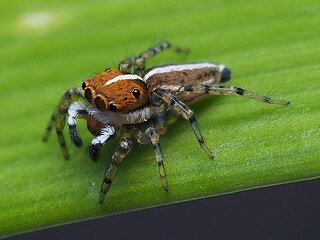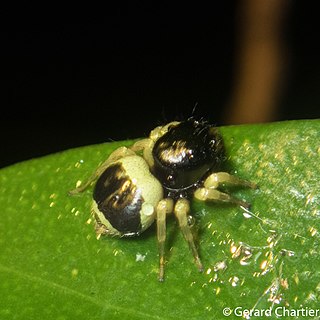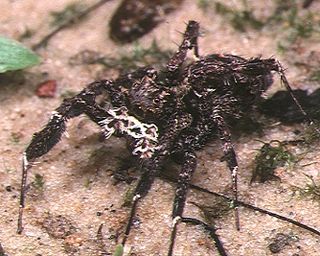
Jumping spiders are a group of spiders that constitute the family Salticidae. As of 2019, this family contained over 600 described genera and over 6,000 described species, making it the largest family of spiders at 13% of all species. Jumping spiders have some of the best vision among arthropods and use it in courtship, hunting, and navigation. Although they normally move unobtrusively and fairly slowly, most species are capable of very agile jumps, notably when hunting, but sometimes in response to sudden threats or crossing long gaps. Both their book lungs and tracheal system are well-developed, and they use both systems. Jumping spiders are generally recognized by their eye pattern. All jumping spiders have four pairs of eyes, with the anterior median pair being particularly large.
Amphidraus is a genus of South American jumping spiders first described by Eugène Simon in 1900. It was previously considered a synonym of Nebridia, but this was later rejected by Jerzy Prószyński, who claimed that merging the two genera wasn't supported by previous diagnostic drawings.
Eupoa is a genus of spiders in the family Salticidae. Originally known only from one species from Vietnam, several other species have been described since 1997, all from China.

Ilargus is a genus of the spider family Salticidae.

Maeota is a spider genus of the jumping spider family, Salticidae.

Marchena is a genus of jumping spiders only found in the United States. Its only described species, M. minuta, dwells on the barks of conifers along the west coast, especially California, Washington and Nevada.

Pystira is a genus of spiders in the jumping spider family Salticidae.

Zygoballus is a genus of jumping spiders found in North and South America.

The Spartaeinae are a subfamily of the spider family Salticidae. The subfamily was established by Fred R. Wanless in 1984 to include the groups Boetheae, Cocaleae, Lineae, Codeteae and Cyrbeae, which in turn were defined by Eugène Simon.

Lyssomaninae is a subfamily of jumping spiders. It includes four genera, three from the New World.

Zygoballus incertus is a species of jumping spider which occurs in Panama.

Simonellini is a tribe of spiders belonging to the Amycoida clade of the subfamily Salticinae of the family Salticidae. The group has been treated at a variety of formal and informal ranks, with different circumscriptions, including as the subfamilies Synemosyninae and Simonellinae. Its species mimic ants and beetles.
Ragatinus is a genus of spiders in the family Salticidae. It was first described in 2016 by Angelika Dawidowicz and Wanda Wesołowska. As of 2017, it contains only one species, Ragatinus maddisoni.
Nepalicius is a genus of spiders in the family Salticidae. It was first described in 2016 by Prószyński. As of 2017, it contains 3 species.
Okinawicius is a genus of spiders in the family Salticidae. It was first described in 2016 by Prószyński. As of 2017, it contains 9 species.
Rudakius is a genus of spiders in the family Salticidae. It was first described in 2016 by Prószyński. As of 2017, it contains 7 species.

Orienticius is a genus of spiders in the family Salticidae. It was first described in 2016 by Prószyński. As of 2017, it contains 2 species.
Junxattus is a monotypic genus of southeast Asian jumping spiders native to Sumatra. It contains the single species, Junxattus daiqini, first described by Jerzy Prószyński and Christa Deeleman-Reinhold in 2012. The genus was placed in the subfamily Euophryinae, the equivalent of the tribe Euophryini.

Lyssomanes viridis, commonly known as the magnolia green jumper, is a species of jumping spider of the genus Lyssomanes, for which it is the type species. The species is native to the United States, being found in much of the Southeastern United States and Texas. It has also been reported from parts of Mexico, with sightings as far south as Guatemala and as far north as Maryland.

Attinella is a genus of North American jumping spiders. It was first described by Nathan Banks in 1905 based on the type species Attinella dorsata. As of March 2022 it contains only three species: A. concolor, A. dorsata, and A. juniperi. It was synonymized with Sitticus from 1979 to 2017, when the genus Sittiab was split from Sitticus by Prószyński in 2017, and Attinella was recognized as its senior synonym.













